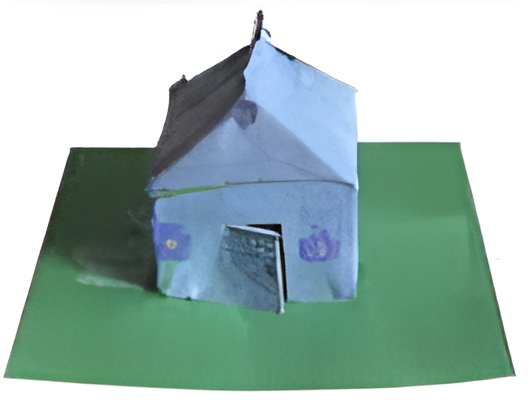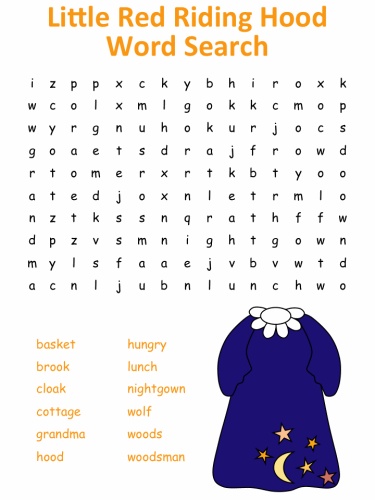DLTK's Fairy Tales Activities
Little Red Riding Hood Activities
Welcome to the "Little Red Riding Hood Activities" section! The first time the story was collected into a book was in Charles Perrault's book published in 1695.
Explore the enchanting world of "Little Red Riding Hood" with our engaging collection of activities. Enjoy a variety of fun and educational resources, including coloring pages, crafts, and printable worksheets that bring the classic fairy tale to life. These activities are designed to foster creativity, fine motor skills, and early learning in young children.

Twisted Tale: A Different Story of Little Red Riding Hood
Crafts to go with this story:

Little Red Riding Hood Activities
Grandma's House Paper Craft (3D House)
Little Red Riding Hood Printable Resources:
Little Red Riding Hood Creative Writing Printables:
Little Red Riding Hood Worksheets:
Little Red Riding Hood Videos:
The History of "Little Red Riding Hood"
"Little Red Riding Hood" is one of the most famous and enduring fairy tales, with a history that dates back several centuries. The tale tells the story of a young girl, Little Red Riding Hood, who goes to visit her grandmother and encounters a wolf along the way. The story explores themes of danger, deception, and the loss of innocence, often ending with the wolf's defeat and the girl's rescue.
Origins and Early Versions
The origins of "Little Red Riding Hood" can be traced back to European oral traditions, with variations of the story appearing in several cultures. The first known written version was published by French author Charles Perrault in 1697, in his collection "Tales and Stories of the Past with Morals," also known as "Mother Goose Tales." Perrault's version emphasized moral lessons about the dangers of talking to strangers and the consequences of naivety.
The story was later popularized by the Brothers Grimm in their collection "Children's and Household Tales," first published in 1812. The Grimms' version, titled "Rotkäppchen" (Little Red Cap), included a happier ending where a huntsman saves Little Red Riding Hood and her grandmother from the wolf. This version has become the most well-known and widely retold iteration of the tale.
Ancient Roots
Some scholars trace the story's origins back to oral traditions dating over 2,000 years ago, with similar tales appearing in ancient Roman, Asian, and African cultures . These early versions often involved different animals or settings but retained the core elements of a young girl encountering danger.
Variations and Adaptations
Over the years, "Little Red Riding Hood" has been adapted and retold in numerous forms, including literature, film, theater, and art. Each adaptation often brings its unique twist to the story, reflecting cultural changes and different interpretations of the tale's themes.
- Literature: Many authors have reimagined the story in various ways, exploring different perspectives or setting the tale in modern contexts. Some adaptations focus on the psychological aspects of the story, while others emphasize empowerment and agency for Little Red Riding Hood.
- Film and Theater: The tale has been adapted into countless films and theatrical productions, ranging from animated children's movies to dark, suspenseful dramas. Each adaptation highlights different elements of the story, from its cautionary messages to its exploration of fear and bravery.
Cultural Impact
"Little Red Riding Hood" has had a significant impact on popular culture and continues to be a source of inspiration for artists, writers, and filmmakers. The story's iconic imagery and universal themes have made it a timeless classic that resonates with audiences worldwide. It remains a staple in children's literature, often used to teach lessons about safety and critical thinking.
Cultural Variations of "Little Red Riding Hood"
"Little Red Riding Hood" is a tale that has been adapted and retold in many cultures around the world, each bringing its unique cultural elements and moral lessons. These variations reflect regional wildlife, cultural themes, and societal values, providing a rich tapestry of interpretations.
Asian Variations
- Chinese Version - "The Tiger Grandmother": In this version, the antagonist is a tiger instead of a wolf. This change reflects the presence and significance of tigers in Chinese culture. The tale, set down by Chinese poet Huang Zhing, is similar in its narrative but adapted to the local environment and animals. The story often blends elements of cautionary tales with local folklore
- "Goldflower and the Bear" (China): In this Chinese variation, the protagonist, Goldflower, faces a bear instead of a wolf. The story emphasizes cleverness and bravery, as Goldflower uses her wits and a knife to escape from the bear's clutches. This version highlights the theme of resourcefulness and courage, encouraging children to think critically and act decisively in the face of danger. It was recorded by Chiang Mi in 1979. This story is a modern adaptation of the classic "Little Red Riding Hood" tale, set in a Chinese context. The story revolves around Goldflower, a young girl who must protect herself and her younger brother from a bear pretending to be their grandmother
European and Middle Eastern Variations
- Italian Version - "La Finta Nonna" (The False Grandmother): In Italy, one popular version is "La Finta Nonna," where the wolf disguises itself as the grandmother, but the protagonist discovers the deception and manages to escape. This version emphasizes the importance of intuition and the ability to recognize danger, teaching children to trust their instincts .
- Middle Eastern Variation - "The Story of the Grandmother": In some Middle Eastern renditions, the tale includes elements of cannibalism and shape-shifting, reflecting local folklore and mythological themes. The protagonist often uses trickery to outsmart the antagonist, reinforcing themes of intelligence and cunning .
African Variations
- Ghanaian Version - "The Wolf and the Seven Little Kids": In this African retelling, the story shifts focus to a group of siblings rather than a single protagonist. The wolf attempts to deceive the children while their mother is away, but they use teamwork and intelligence to overcome the threat. This version emphasizes communal values and cooperation .
Cultural Themes and Lessons
- Adaptation to Local Wildlife: Many cultural versions adapt the antagonist to fit local wildlife, such as replacing the wolf with a tiger or a bear. This change not only makes the story more relatable to the audience but also incorporates cultural symbols and values related to these animals.
- Moral Lessons: Across cultures, the tale often conveys moral lessons about caution, bravery, and the importance of intelligence. While the details and characters may change, the core messages remain relevant and impactful for children.
- Reflecting Social Values: These variations also reflect societal values, such as the importance of family, the power of intuition, and the virtues of cleverness and cooperation. They offer insights into how different cultures perceive danger and how they teach young audiences to navigate challenges.
These cultural variations highlight the universal appeal of "Little Red Riding Hood" while showcasing the diverse ways in which societies adapt stories to reflect their unique cultural landscapes. The enduring nature of the tale and its ability to resonate across different cultures speak to its timeless themes and storytelling power .
Educational Uses
In educational settings, "Little Red Riding Hood" is used to teach storytelling, literacy, and moral lessons. The tale's simple structure and vivid characters make it an effective tool for engaging young readers and encouraging discussions about themes such as trust, caution, and resourcefulness.

 Coloring Pages for Little Red Riding Hood
Coloring Pages for Little Red Riding Hood Mini Book for Little Red Riding Hood
Mini Book for Little Red Riding Hood
















